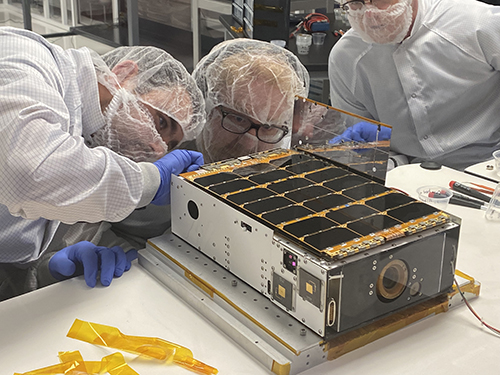College of Science
Morehead State's Lunar IceCube tentatively set for late spring launch aboard Artemis I
 A satellite built by students and faculty at Morehead State is tentatively scheduled to head into space late this spring aboard the most powerful spacecraft ever made as part of a NASA mission to the moon.
A satellite built by students and faculty at Morehead State is tentatively scheduled to head into space late this spring aboard the most powerful spacecraft ever made as part of a NASA mission to the moon. The satellite, Lunar IceCube, passed environmental testing last summer and was delivered to NASA's Kennedy Space Center to be installed as a secondary payload on the Artemis I mission, tentatively scheduled for a June launch date. The satellite will use a plasma drive propulsion system to take it on a circuitous route to the moon. It will orbit and investigate the transportation physics of water ice on the lunar surface to support a lunar outpost that NASA plans to develop. NASA hopes that there is enough water on the moon to support future human and robotic solar system exploration.
The Lunar IceCube team includes several faculty and staff members of the Space Science Center and more than 50 students at Morehead State, in addition to a small number of scientists and engineers from NASA Goddard Spaceflight Center, the NASA Jet Propulsion Laboratory, the NASA Independent Verification and Validation Center and the Busek Space Propulsion company.
Lunar IceCube's mission will last approximately 18 months and the spacecraft will perform hundreds of orbits of the moon. The Mission Operations Center (MOC) in the Space Science Center at Morehead State University will operate the mission. The team will use NASA's Deep Space Network and Morehead State University's own 21-meter ground station antenna to send commands to the spacecraft and downlink data and telemetry.
"Lunar IceCube is one of the first of a generation of higher capability CubeSat spacecraft that represents a transition of the technology from Low Earth Orbiting (LEO) satellites to Interplanetary missions," said Nathan Fite, MSU space systems engineer and Lunar ICECube program manager. "The Artemis 1 missions bridge the gap between LEO CubeSats and larger interplanetary space missions."
For more information about Lunar IceCube and the Artemis I mission, visit https://go.nasa.gov/3wgwJVO.
To explore programs in MSU's Department of Physics, Earth Science and Space Systems Engineering, visit www.moreheadstate.edu/phes, email phes@moreheadstate.edu or call 606-783-2381.
Photo Caption: Kevin Fite, Lunar IceCube project manager and instructor of space systems engineering at MSU (center), works with students to construct the Lunar IceCube satellite.
